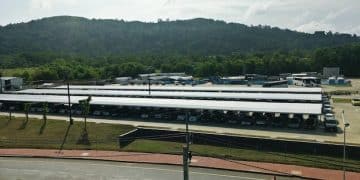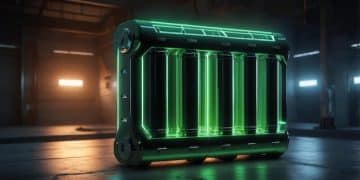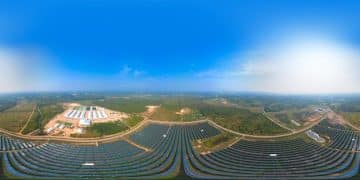Beyond Lithium-Ion: Emerging Battery Tech for US Energy Storage in 2025

Beyond Lithium-Ion (Li-ion) battery technology, the United States seeks innovative energy storage solutions for 2025, exploring promising alternatives like solid-state batteries, sodium-ion batteries, redox flow batteries, and advanced lead-acid batteries to enhance energy density, safety, and sustainability.
As the United States looks toward a future powered by renewable energy, the need for efficient and reliable energy storage solutions becomes ever more critical. While beyond Lithium-Ion: exploring emerging battery technologies for US energy storage applications in 2025 remains a key player, exploring what advanced technologies will power the grid is crucial. What alternatives are on the horizon for energy storage in the US?
Exploring Alternatives to Lithium-Ion Batteries
Lithium-ion batteries have been the workhorse of energy storage for years, powering everything from electric vehicles to grid-scale storage systems. However, their limitations in terms of energy density, safety, and cost have spurred research into alternative battery technologies.
The US is at the forefront of this innovation, seeking to develop and deploy advanced battery solutions that can overcome these challenges. We’re going to dive into some of the most promising alternatives to Li-ion batteries that are expected to make an impact by 2025.
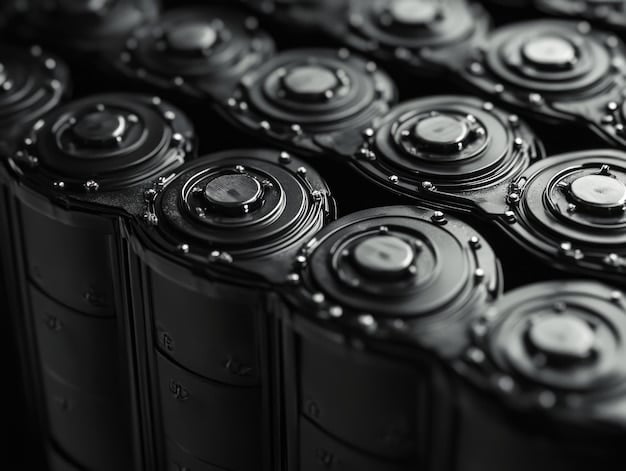
Solid-State Batteries: The Next Generation
Solid-state batteries are considered a game-changer in the battery industry, offering several advantages over traditional Li-ion batteries. Instead of using a liquid electrolyte, solid-state batteries employ a solid electrolyte, which is non-flammable and allows for higher energy density.
- Increased Safety: The solid electrolyte eliminates the risk of electrolyte leakage and thermal runaway, making these batteries much safer.
- Higher Energy Density: Solid-state batteries can potentially store more energy in a smaller volume, leading to longer driving ranges for electric vehicles and more efficient grid storage.
- Faster Charging: The solid electrolyte facilitates faster ion transport, enabling quicker charging times.
Multiple companies, including QuantumScape and Solid Power, are heavily investing in solid-state battery technology, and pilot production lines are expected to be operational by 2025. Widespread adoption, however, may take longer due to manufacturing challenges and cost considerations.
In conclusion, solid-state batteries represents a significant leap forward in battery technology, offering enhanced safety, higher energy density, and faster charging capabilities, making them a promising alternative to lithium-ion batteries.
Sodium-Ion Batteries: Affordable and Abundant Alternative
Sodium-ion (Na-ion) batteries have emerged as a viable alternative to Li-ion batteries because of the abundance and low cost of sodium. Sodium is a key component in these batteries, and because it is readily available, Na-ion batteries also mitigate a major concern about Li-ion production.
Unlike lithium, which faces supply chain constraints and geopolitical concerns, sodium is readily available in seawater and other sources. This makes Na-ion batteries an attractive option for large-scale energy storage applications.
Key Advantages of Sodium-Ion Technology
Sodium-ion batteries are similar in design to Li-ion batteries, but they use sodium ions instead of lithium ions to carry the electrical charge. Beyond cost, several other factors make them worth watching.
- Cost-Effectiveness: Sodium is significantly cheaper than lithium, which can lead to lower battery costs.
- Thermal Stability: Na-ion batteries exhibit better thermal stability than Li-ion batteries, reducing the risk of overheating and fire.
- Sustainable Materials: The use of abundant and sustainable materials makes Na-ion batteries an environmentally friendly option.
Companies like Natron Energy are pioneering the development of Na-ion batteries for data centers and grid storage. While their energy density is lower than Li-ion batteries, ongoing research aims to improve their performance. Many experts predict Na-ion batteries will find niche applications by 2025, particularly in stationary energy storage.
In conclusion, sodium-ion batteries offer a compelling alternative to lithium-ion, especially for large-scale energy storage where cost and sustainability are paramount.
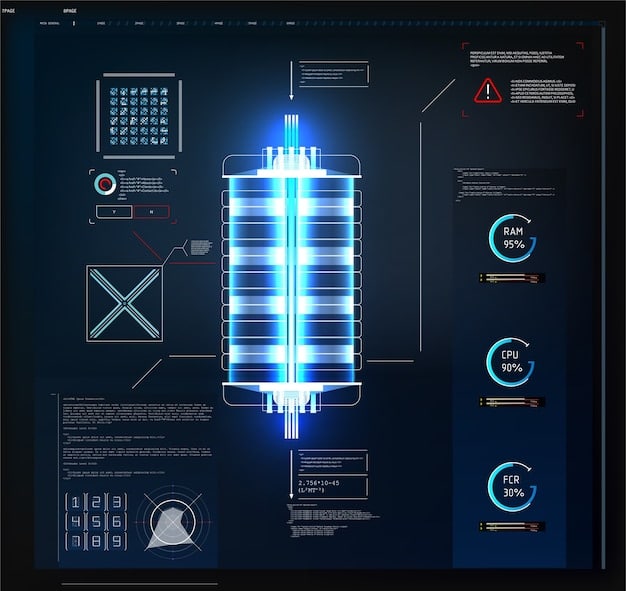
Exploring Redox Flow Batteries for Grid-Scale Storage
Redox flow batteries (RFBs) are a type of rechargeable battery where energy is stored in liquid electrolytes that flow through an electrochemical cell. This unique design offers several advantages, particularly for grid-scale energy storage applications.
These batteries are distinct from other technologies in this list because they can be designed for very large applications; they function more like chemical plants than typical batteries.
The Advantages of Redox Flow Batteries
Redox flow batteries offer a distinct advantage because their energy capacity is determined by the size of the electrolyte tanks, and the power output is determined by the size of the electrochemical cell.
- Scalability: RFBs can be easily scaled up by increasing the size of the electrolyte tanks, making them suitable for large-scale energy storage.
- Long Lifespan: RFBs have a long cycle life, with some systems capable of operating for over 20 years with minimal degradation.
- Decoupled Power and Energy: The ability to independently scale power and energy allows for flexible system design.
Companies like Primus Power and ESS Inc. are deploying RFB systems for grid stabilization and microgrid applications. Vanadium redox flow batteries (VRFBs) are the most common type, but research into alternative chemistries, such as zinc-based RFBs, is ongoing to improve performance and reduce costs. By 2025, RFBs are expected to play a significant role in grid-scale energy storage, especially for applications requiring long-duration storage.
In conclusion, redox flow batteries represent great potential for grid-scale energy storage due to their scalability, long lifespan, and flexible design, making them a vital technology for stabilizing the grid and supporting renewable energy integration.
Advanced Lead-Acid Batteries: An Evolving Technology
While lead-acid batteries may seem like an outdated technology, ongoing innovations have led to the development of advanced lead-acid batteries with improved performance and lifespan.
These advanced versions offer a cost-effective and reliable solution for various energy storage applications, especially for backup power and microgrids.
Innovations in Lead-Acid Battery Technology
Advanced lead-acid batteries incorporate new materials and designs to enhance performance and overcome the limitations of traditional lead-acid batteries. Many of these are related to electrolyte management.
- Enhanced Cycle Life: New additives and electrode designs extend the cycle life of lead-acid batteries, making them more durable and reliable.
- Improved Energy Density: Advanced lead-acid batteries offer higher energy density compared to traditional versions, allowing for more compact energy storage systems.
- Cost-Effectiveness: Lead-acid batteries remain a cost-effective option, especially for applications where high energy density is not a primary concern.
Companies like East Penn Manufacturing and Trojan Battery Company are producing advanced lead-acid batteries for various applications. They’re a solid choice for many applications, especially for hybrid systems. Although they may not compete with Li-ion directly in terms of energy density, advanced lead-acid batteries are expected to maintain their presence in the energy storage market by 2025 due to their affordability and reliability.
In conclusion, advanced lead-acid batteries represent an evolving technology that continues to offer a cost-effective and reliable energy storage solution for numerous applications, particularly in backup power and microgrids.
Policy and Investment Driving Battery Innovation
The US government is actively promoting the development and deployment of advanced battery technologies through various policies and investment initiatives.
Federal and state-level incentives, research grants, and tax credits are playing a crucial role in accelerating battery innovation and manufacturing.
Government Support for Energy Storage
With the right amount of support, many of these technologies could quickly scale, making them much more useful for domestic energy independence and sustainability.
- DOE Initiatives: The Department of Energy (DOE) is funding research and development projects aimed at improving battery performance, reducing costs, and enhancing manufacturing capabilities.
- Tax Credits: Federal tax credits incentivize the deployment of energy storage systems, making them more economically viable for businesses and homeowners.
- State Policies: Several states have implemented policies and mandates to promote energy storage, such as California’s Self-Generation Incentive Program (SGIP).
The Bipartisan Infrastructure Law and the Inflation Reduction Act have allocated billions of dollars to support battery manufacturing and energy storage projects in the US. These investments are expected to drive significant growth in the battery industry and accelerate the adoption of alternative battery technologies by 2025.
In conclusion, robust policy support and strategic investments are essential for fostering battery innovation and ensuring that the US remains a leader in the global energy storage market.
Challenges and Opportunities in the Battery Market
While alternative battery technologies offer great promise, several challenges need to be addressed to ensure their widespread adoption.
These challenges range from technical hurdles to supply chain constraints and regulatory barriers.
Navigating the Road Ahead
The path toward widespread adoption for many of the technologies on this list faces headwinds, making it important for policymakers and businesses to work together.
- Technical Challenges: Some alternative battery technologies, such as solid-state batteries, still face technical challenges related to manufacturing scalability and long-term performance.
- Supply Chain Constraints: Securing a stable and sustainable supply of raw materials, such as lithium, nickel, and cobalt, is critical for battery production.
- Regulatory Barriers: Streamlining the permitting process for energy storage projects and establishing clear regulatory frameworks are essential for attracting investment and accelerating deployment.
Despite these challenges, the energy storage market presents significant opportunities for innovation, economic growth, and job creation. By addressing these challenges and capitalizing on these opportunities, the US can build a robust and resilient energy storage ecosystem that supports a clean energy future. By 2025, strategic partnerships, continued R&D, and supportive regulatory frameworks will be crucial for unlocking the full potential of alternative battery technologies.
In conclusion, overcoming technical challenges, addressing supply chain constraints, and navigating regulatory barriers are critical steps for realizing the full potential of alternative battery technologies and driving growth in the energy storage market.
| Key Point | Brief Description |
|---|---|
| ⚡Solid-State Batteries | Offers higher safety, energy density, and faster charging. |
| 💰Sodium-Ion Batteries | Cost-effective alternative with good thermal stability. |
| 🌊Redox Flow Batteries | Scalable for grid storage with long lifespans. |
| 🔋Advanced Lead-Acid | Cost-effective, improved performance for backup power. |
Frequently Asked Questions
▼
Lithium-ion batteries face limitations in safety due to flammable electrolytes, constraints in energy density affecting range, and concerns over the sustainability and ethical sourcing of materials like lithium and cobalt.
▼
Solid-state batteries enhance safety by using a non-flammable solid electrolyte, increase energy density for better performance, allow faster charging, and potentially reduce size and weight for various applications.
▼
Sodium-ion batteries are sustainable because sodium is abundant and readily available from seawater, reducing reliance on scarce materials like lithium, and they offer good thermal stability, enhancing safety.
▼
Redox flow batteries feature scalable energy capacity via larger electrolyte tanks, boast long lifespans of over 20 years, and independently adjustable power/energy, making them ideal for grid stabilization and renewable energy integration.
▼
Advanced lead-acid batteries are relevant for backup power, microgrids, and hybrid systems due to their cost-effectiveness and improved cycle life, providing a reliable and economical energy storage solution for certain applications.
Conclusion
The quest to move beyond Lithium-Ion: exploring emerging battery technologies for US energy storage applications in 2025 is driven by the need for safer, more efficient, and sustainable energy solutions. While lithium-ion batteries have served us well, innovations in solid-state, sodium-ion, redox flow, and advanced lead-acid batteries promise a diverse and resilient energy storage landscape. With continued investment, supportive policies, and collaborative research, the US is poised to lead the world in battery technology and secure a clean energy future.


